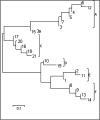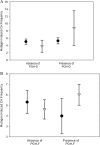A comprehensive haplotype analysis of the XPC genomic sequence reveals a cluster of genetic variants associated with sensitivity to tobacco-smoke mutagens
- PMID: 20106949
- PMCID: PMC2855352
- DOI: 10.1093/toxsci/kfq027
A comprehensive haplotype analysis of the XPC genomic sequence reveals a cluster of genetic variants associated with sensitivity to tobacco-smoke mutagens
Abstract
The impact of single-nucleotide polymorphisms (SNPs) of the DNA repair gene XPC on DNA repair capacity (DRC) and genotoxicity has not been comprehensively determined. We constructed a comprehensive haplotype map encompassing all common XPC SNPs and evaluated the effect of Bayesian-inferred haplotypes on DNA damage associated with tobacco smoking, using chromosome aberrations (CA) as a biomarker. We also used the mutagen-sensitivity assay, in which mutagen-induced CA in cultured lymphocytes are determined, to evaluate the haplotype effects on DRC. We hypothesized that if certain XPC haplotypes have functional effects, a correlation between these haplotypes and baseline and/or mutagen-induced CA would exist. Using HapMap and single nucleotide polymorphism (dbSNP) databases, we identified 92 SNPs, of which 35 had minor allele frequencies >or= 0.05. Bayesian inference and subsequent phylogenetic analysis identified 21 unique haplotypes, which segregated into six distinct phylogenetically grouped haplotypes (PGHs A-F). A SNP tagging approach used identified 11 tagSNPs representing these 35 SNPs (r(2) = 0.80). We utilized these tagSNPs to genotype a population of smokers matched to nonsmokers (n = 123). Haplotypes for each individual were reconstituted and PGH designations were assigned. Relationships between XPC haplotypes and baseline and/or mutagen-induced CA were then evaluated. We observed significant interaction among smoking and PGH-C (p = 0.046) for baseline CA where baseline CA was 3.5 times higher in smokers compared to nonsmokers. Significant interactions among smoking and PGH-D (p = 0.023) and PGH-F (p = 0.007) for mutagen-induced CA frequencies were also observed. These data indicate that certain XPC haplotypes significantly alter CA and DRC in smokers and, thus, can contribute to cancer risk.
Figures



References
-
- Abdel-Rahman SZ, El-Zein RA. The 399Gln polymorphism in the DNA repair gene XRCC1 modulates the genotoxic response induced in human lymphocytes by the tobacco-specific nitrosamine NNK. Cancer Lett. 2000;159:63–71. - PubMed
-
- Abdel-Rahman SZ, Salama SA, Au WW, Hamada FA. Role of polymorphic CYP2E1 and CYP2D6 genes in NNK-induced chromosome aberrations in cultured human lymphocytes. Pharmacogenetics. 2000;10:239–249. - PubMed
-
- Affatato AA, Wolfe KJ, Lopez MS, Hallberg C, Ammenheuser MM, Abdel-Rahman SZ. Effect of XPD/ERCC2 polymorphisms on chromosome aberration frequencies in smokers and on sensitivity to the mutagenic tobacco-specific nitrosamine NNK. Environ. Mol. Mutagen. 2004;44:65–73. - PubMed
-
- An J, Liu Z, Hu Z, Li G, Wang LE, Sturgis EM, El-Naggar AK, Spitz MR, Wei Q. Potentially functional single nucleotide polymorphisms in the core nucleotide excision repair genes and risk of squamous cell carcinoma of the head and neck. Cancer Epidemiol. Biomarkers Prev. 2007;16:1633–1638. - PubMed
-
- Araki M, Masutani C, Takemura M, Uchida A, Sugasawa K, Kondoh J, Ohkuma Y, Hanaoka F. Centrosome protein centrin2/caltracin1 is part of the xeroderma pigmentosum group c complex that initiates global genome nucleotide excision repair. J. Bio. Chem. 2001;276:18665–18672. - PubMed

